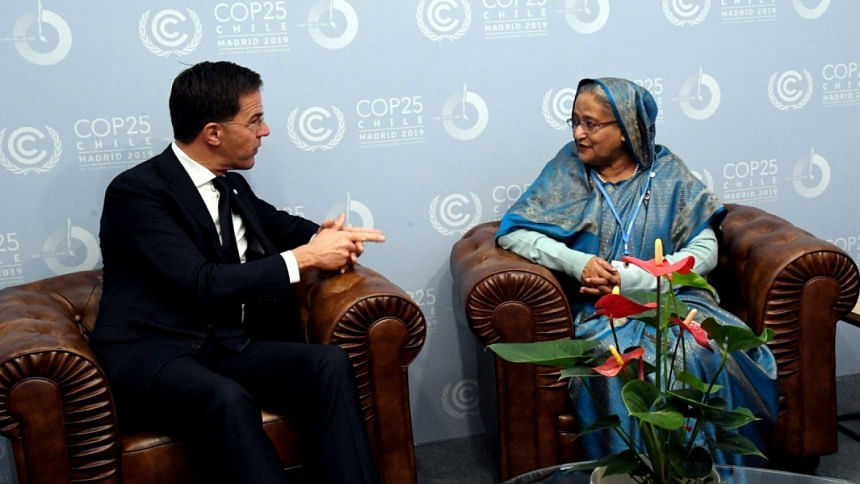Time for a new direction as Bangladesh moves to take the helm

The Climate Vulnerable Forum (CVF) currently consists of 48 vulnerable developing countries from all the different groups of vulnerable countries under the United Nations Framework Convention on Climate Change (UNFCCC). The CVF was formed by then President Nasheed of the Maldives in 2009 in the run up to the fifteenth Conference of Parties (COP15) held in December 2009 in Copenhagen, Denmark, where we expected a new climate change agreement to emerge.
What President Nasheed did was to invite heads of government from around 20 key developing countries selected from each of the negotiating groups to a three-day meeting in Male, Maldives to strategise on one or two high-level advocacy demands on behalf of all the vulnerable developing countries. At the end of the meeting, the leaders decided to form the CVF with President Nasheed as its chair for the first two years. They also decided to focus on a single high-level advocacy message: to change the global long-term temperature goal from 2 degrees Centigrade to 1.5 degrees.
During COP15 in Copenhagen, Nasheed spearheaded the CVF leaders to press for this demand. Unfortunately, he was not successful in getting others to agree to the demand as both the developed and big developing countries failed to support us (it's interesting to note that this was the only point in which the presidents of both the US and China agreed with each other!).
However, Nasheed managed to insert a small paragraph at the end of the Copenhagen Agreement that said there would be a review of the long-term temperature goal between 2013 and 2015. This paragraph allowed the UNFCCC Secretariat to set up a scientific group to examine the difference of impacts between 2 degrees Centigrade warming and 1.5 degrees, and the expert report was published in 2015 which showed that while 2 degrees was good enough to protect most of the world's countries and people, it would still affect many millions of people living in the poorest countries. Hence, 1.5 degrees was essential if the global leaders wished to protect all people on the planet.
This report then allowed the CVF, then under the leadership of President Aquino of the Philippines, to galvanise support at the beginning of COP21 in Paris, in December 2015, where we managed to get the long-term temperature goal down to 1.5 degrees Centigrade. This was a big achievement for the CVF.
As we move towards COP26, which will be held in Glasgow, Scotland in November 2020, under the presidency of the United Kingdom, the CVF will again have an opportunity to play an important role in galvanising ambition by all countries to enhance their mitigation plans to make them compatible with the 1.5-degree-Centigrade temperature goal. Unfortunately, at the current levels of national plans, we are still headed for 3 degrees, let alone even 2 degrees!
At the beginning of COP25 in Madrid, there was a high-level session of the CVF where President Hilda Heine of the Marshall Islands, the current chair who will serve until mid-2020, announced that she had invited Prime Minister Sheikh Hasina of Bangladesh to become the next CVF chair from mid-2020 onwards. Thus, during COP26 in Glasgow, Sheikh Hasina will be responsible for galvanising support for raising the ambition to meet the 1.5 degrees Centigrade goal.
So as Bangladesh prepares to take up the challenge of chairing the CVF for the next two years, there are a number of things that should be taken into consideration.
The first thing is to bring this role under the direct command of the prime minister's own office, with all the other relevant ministries such as environment, foreign affairs, finance, and planning playing a supportive role.
The second thing is for the prime minister to consider appointing a Special Envoy for Climate Change, as some countries have already done. For example, President Hilda Heine appointed her own daughter to the post in the Marshall Islands. The Special Envoy's role is not just to attend the annual COPs but rather to undertake high-level political diplomacy with all the major countries on behalf of the prime minister. He or she should have experience in international diplomacy and have the confidence of the prime minister herself. Expertise in climate change is not essential as that can be provided by the ministry of environment as well as the Expert Advisory Group of the CVF.
The third priority should be to immediately chalk out a two-year programme for Bangladesh's chairmanship of the CVF so that we can hit the ground running as soon as the responsibility of the chair is officially handed over to Prime Minister Sheikh Hasina in mid-2020.
Finally, it is important to remember that once that happens, we must become the spokesperson for all the vulnerable countries and not just promote Bangladesh alone. We should also change the narrative of the CVF by shifting our focus from our vulnerability to our resilience. Perhaps we can also weigh the possibility of changing the name of the group from Climate Vulnerable Forum (CVF) to Climate Resilient Forum (CRF)?
Saleemul Huq is Director, International Centre for Climate Change and Development at the Independent University, Bangladesh.

 For all latest news, follow The Daily Star's Google News channel.
For all latest news, follow The Daily Star's Google News channel. 



Comments